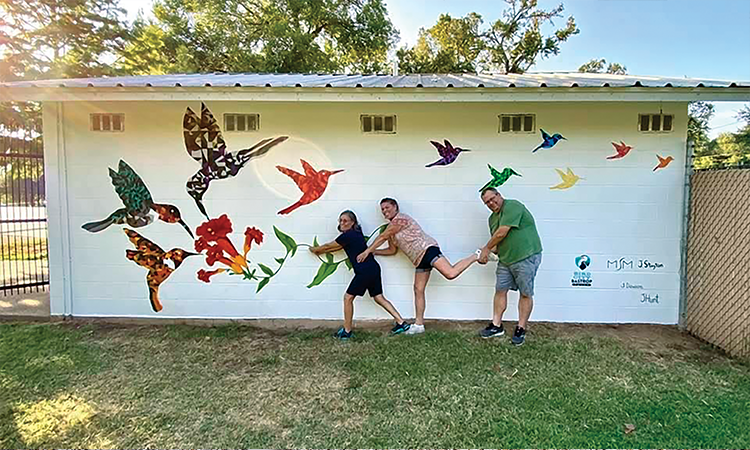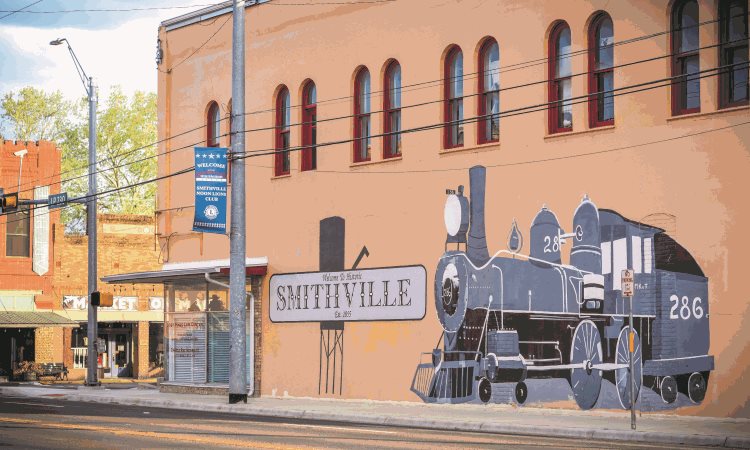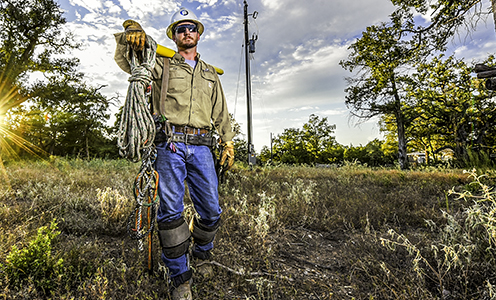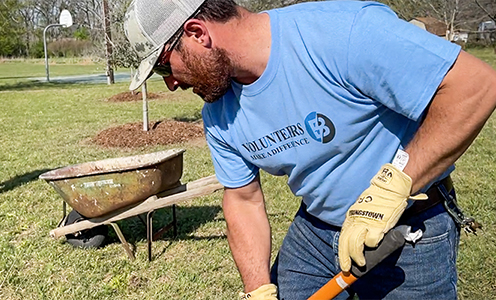Power on
Recent news
By Ed Crowell
Each issue of a local newspaper offers a time capsule of contemporary life, capturing the ups and downs of any town, big or small.
Community newspapers across the Bluebonnet Electric Cooperative service area are by, for and about local residents. Their unique blend of hyper-local news, school sports stories, community events coverage and personality-driven columns by local residents keeps readers paying attention — and paying to read.
Many of them have been publishing for well over 100 years, too.
While big newspapers in Houston, Dallas, Austin, San Antonio and some other cities publish seven days a week, this region’s small-town newspapers print once, twice or three times a week. Most now offer digital versions or news update emails.
In addition to their longevity and remaining the resource of record for many communities, they perform an important service: getting useful information to readers, said Jeff Wick, the enthusiastic managing editor of the Fayette County Record.
“Community newspapers like us are still vital because nobody besides us is doing in-depth coverage of local government and law enforcement,” he said. “Nobody besides us is interviewing local athletes as they excel. Nobody besides us is reaching the ever-growing numbers of people who are turning away from social media as a reliable source of news.”
Wick, who began working at the newspaper in 2009, says the twice-weekly Record’s circulation is growing. “We have a very loyal subscriber base. While most newspapers have seen their print circulation plummet over the past decade, we’ve really held our own.”
The coronavirus pandemic caused business closures and public gathering restrictions over the past 18 months that negatively affected newspapers, he said. But “we still have a very robust classified section. Retail print advertising has been curtailed by the pandemic, but we are hopeful that will return as local events (come back) post-pandemic.”
Wick and the Fayette County Record publisher Regina Barton Keilers had a conversation as the COVID-19 crisis began to unfold in early 2020 and non-essential businesses were closing.
“She asked if we should (close), too,” Wick said. “I thought it was important to the community that we keep the doors open, a symbol that we’re still here for you. Immediate pay-off came a few days later when the county judge strolls in and — because we are open and available — let us know about Fayette County’s first confirmed case of COVID.”
In a pandemic, small newspapers are more important than ever, said Mike Hodges, executive director of the Texas Press Association. “That’s the only way people in some communities can get current local information. You need that news in emergencies like this.”
Up and down Main Street in small towns, many businesses closed temporarily or for good because of the pandemic. “That means they were not advertising in the local papers. It’s been a struggle,” Hodges said.
At the same time, many public agencies were not easily accessible because of coronavirus restrictions, so newspapers have been relying more on open-record requests for public documents. “Some agencies were taking a month to respond, citing skeleton crews in offices and employees working from home. That was too long,” Hodges said.
Texas has 75 daily newspapers and 388 weeklies, according to the Texas Press Association. “We’re a resource to help them manage their businesses in terms of sharing information,” Hodges said. “If they have a question, for example, of how to handle paid versus free obituaries, we connect them via [a group email list] to the experiences of other newspapers. That interaction with other publishers is priceless.”
The Texas Center for Community Journalism, based at Tarleton State University in Stephenville, is another resource for small newspapers. It provides free training on a variety of subjects to help small newspapers survive in an ever-changing business environment.
Publishers and editors of nine newspapers in the Bluebonnet region spoke about their publications and the role they play in their communities.
The Bastrop Advertiser and The Smithville Times
An unusual ownership arrangement is in place for two weeklies in Bastrop County. The Bastrop Advertiser and The Smithville Times are published by the daily Austin American-Statesman, which is owned by the national Gannett Co. newspaper chain.
The newspapers have deep community roots. The Bastrop Advertiser was first published in 1853 and today has 5,000 subscribers. The Smithville Times, with 2,500 subscribers, began publishing in 1894.
Andy Sevilla has been editor of the two community papers since 2015. He and one full-time reporter write for both the Advertiser, which has Thursday and Saturday editions, and for the Times’ single Thursday edition. He writes two or three stories a week and the reporter writes at least five stories a week.
Their articles often appear on the Austin American-Statesman website, statesman.com, and occasionally in that paper’s print edition.
Content overlaps in the two papers at times, such as news from the Bastrop County Commissioners Court meetings. The towns are only 13 miles apart, so major news events in one town are likely of interest in the other. Business coverage also often overlaps.
The front page of each edition is “hyper local” for each town, though, Sevilla said.
Both papers typically are 12 pages on Thursdays, and on Saturday the Bastrop edition is usually 8 pages. Freelance columnist Debbie Moore writes about social, historical and entertainment events. Bill McCann, Joni Ashbrook and Don Loucks all write political opinion columns twice a month.
“We cover all the major high school sports as much as we can with freelancers,” Sevilla said.
The pandemic kept Sevilla away from the newspaper’s office in Bastrop, but he said remote coverage of government meetings was possible when public officials began meeting in an online format via Zoom.
Although the daily Austin American Statesman is printed in Houston now, the Bastrop and Smithville papers are printed in Corpus Christi. That makes deadlines 24 hours in advance of publication. “We have to work harder to make sure the stories will still have a shelf life and are of value to the readers,” Sevilla said.
During the pandemic, single-copy newspaper sales dropped dramatically at grocery and convenience stores and at Walmart, but those sales have been bouncing back recently.
“Growth is definitely making its way to the Lost Pines region, so a lot of our coverage involves the opening of new businesses,” Sevilla said. Local government and school news is a priority, too.
“The Bastrop Advertiserr has a storied past as the oldest weekly newspaper still existing in Texas,” Sevilla said. “With such a rich history, we put great effort into reflecting our community pride in the stories we tell.
“I love what I do, and I’d encourage anyone to pick up our papers and see how we cover our area.”
The Brenham Banner Press
In Washington County, the Brenham Banner-Press publishes three days a week with a personal touch on the bottom of every front page: “Happy birthday wishes to . . .”
Friends and relatives of people celebrating birthdays contact the paper with names and dates for Page One display. “It’s a nice tradition that’s been around longer than I’ve been here,” said Derek Hall, the publisher and editor who started at the Banner Press as a photographer 21 years ago.
The newspaper published six days a week until the coronavirus pandemic hit, when many businesses closed or stopped advertising. Hall doesn’t foresee more than three issues a week anytime soon, but the paper emails breaking stories to its 1,000 digital subscribers. It has 4,500 total subscribers.
Fourteen full-time employees produce the paper, which has its own press. Eight other Houston-area newspapers are printed there. Most Banner-Press editions are 12 to 16 pages, with two or three magazine style sections printed each month to celebrate seasons, holidays and events such as the annual German heritage themed Brenham Maifest.
“We pride ourselves on being local first,” Hall said. “We’re here for the community. That’s our main objective.” Another fixture at the bottom of the front page of each issue is a “Water Usage” list. Brenham is dependent on nearby Lake Somerville for drinking water and the lake is a popular fishing and boating area, so the lake levels are reported regularly. Rainfall amounts and city water use also are listed.
Two longtime column writers provide interesting viewpoints: Bill Neinast, a retired Army colonel, writes about the military and other issues, and Cathy Ganske writes about a variety of topics, ranging from gardening to politics, in Cathy’s Corner.
The Burleson County Tribune
The Burleson County Tribune, founded in 1884, is a small weekly newspaper with a long history. Based in Caldwell, the newspaper also covers news from the towns of Snook and Somerville. It has a paid circulation of 3,129. The digital issue is delivered to 243 subscribers.
Editor Roy Sanders said all local high school sports are big news in the area because so many families are involved.
In spring 2021, a 16- page issue featured five pages of coverage of high school basketball games. Many large color photos captured the boys’ and girls’ teams in action.
The Burleson County Fair each September is another major source of news as students prepare, show and auction their animals. “It’s our biggest event (to cover) by far,” Sanders said.
The Tribune also devotes major coverage to the annual Kolache Festival in Caldwell and the yearly Chilifest country music event near Snook. The two day Chilifest Music Festival draws thousands of fans from Texas A&M University, but the April show was canceled in 2020 and this year as well because of the coronavirus.
The paper has retained most of its advertisers during the pandemic. “It was more difficult, but we have a good footprint here in the area,” Sanders said. “We take pride in the coverage we have that no one else can provide. There are many things in the Tribune not available elsewhere, except maybe on social media. But we think we’re still rocking on.”
Circulation is expected to rise, Sanders said. “We’re seeing a lot of growth in Snook, with new homes being built for people who find they easily can commute to jobs at Texas A&M,” he said.
Preuss Printing Co. owns the Burleson County Tribune and seven other Texas newspapers, including those in Luling (Caldwell County), Bellville (Austin County) and Giddings (Lee County).
The Lockhart Post-Register
In Caldwell County, the Lockhart Post-Register has been read by residents since 1872. Current publisher Dana Garrett bought the newspaper in 1979, at age 24.
He’s seen many changes in the town and the newspaper in recent years, but nothing has affected his staff like the long-lasting pandemic.
“We went from eight staff members to just four when advertising drops hit us pretty bad,” he said. “We acted like we just bought a new paper and started over again with zero based budgeting.”
Single-copy sales at H-E-B, Walmart and other locations dropped by half because many people used curbside pickup or self-service checkout for health safety. The paper’s circulation is about 2,000 now, a decrease of 900 subscribers.
Still, Garrett is convinced the value of the Post-Register will win out. “When people look at our newspaper, they know what’s in there is the truth. If they hear about rumors, they’ll get the paper to see what’s true. Facebook can’t be trusted for that,” he said.
Coverage of Lockhart’s high school sports was tough when reporters and photographers were not allowed into games because of pandemic restrictions. “Coaches got us the information about games because they knew how important that was for the kids and parents,” Garrett said.
Lockhart City Council and Caldwell County Commissioners Court coverage was also difficult when the meetings could only be viewed online. Discussions could not always be heard clearly and reporters were not there to ask questions following the meetings. “That was challenging and required a lot of calling after the meetings to clarify what was said,” Garrett said. Fortunately, some of the meetings now are open for reporters to attend.
The Post-Register is usually 10 pages each week, with regular special sections for events such as the annual Chisholm Trail Roundup festival and the Diez y Seis celebration every September. The newspaper is printed in Bryan.
“I think community newspapers will come back just like movie theaters have done in recent years,” Garrett said. “The theaters rebranded themselves with more comfortable seats and beer and such. Now, community newspapers are looking at how they can change for the better to keep up with the times.”
The Elgin Courier
At the 131-year-old Elgin Courier in Bastrop County, Heather Ott has been slowly transitioning to the publisher’s role after serving as general manager for 10 years. Her first job was as a receptionist in the front office before moving into advertising sales. She is a third-generation Courier employee.
Two full-time reporters and a “whole bunch” of freelance writers and photographers fill the paper each Wednesday, Ott said. Stories are updated online as needed. The newspaper has 2,300 subscribers.
An annual “Best of the Best Readers’ Choice Awards” special section last spring showed how grateful Elgin residents were in difficult times. More than 17,000 votes were cast for favorite local businesses and owners, four times more than in previous years.
Once a month, special sections focus on town events and professions including medical services, high school graduation and the annual Western Days festival.
A long wrap-up article about life during a full year of the pandemic in Bastrop County ran on the front page in March. An updated list of county coronavirus case numbers and vaccine availability was printed weekly until recently.
In addition to paid subscriptions, the Courier sends 400 copies of the paper to local public schools for the Newspapers in Education program.
“People say newspapers are dead, but I say that’s wrong,” Ott said. “Our community is what keeps us alive and kicking. I’m happy to say a lot of people around town love us and look to us for events and news.”
The Giddings Times & News
The Giddings Times & News is a long-lived publication in Lee County, first published in 1888. It is part of a family-owned and operated group of seven weekly newspapers under the Preuss Printing Co. banner.
Sloan Preuss is managing editor in Giddings and one of the sons of company founder and Times & News publisher Buddy Preuss, who has been writing two columns for the Giddings paper for more than 50 years.
“One is the Viewpoint column about people and events of interest, and the other is a religious column called Solid Ground, about teachings in the Bible,” Sloan Preuss said.
In his Viewpoint of June 17, Buddy Preuss described a fast-moving thunderstorm that lifted a storage building off its foundation at Wilbert’s Tire Center in Giddings.
In the same column he wrote about mushrooms, which “I’ve grown to really like eating as part of a meal. . . . One thing I didn’t know is that mushrooms make good fertilizer for gardens. I recently learned that from a friend and loyal reader.”
That June issue of the Giddings Times & News, which has a circulation of 5,200, featured seven front page stories, including one about a favorable Lee County government audit, another about the Lee County 4-H healthy lifestyles team winning a state competition and one about the new superintendent for the Dime Box Independent School District. The 12-page issue concluded with photos from the Dime Box High School graduation ceremony.
Sloan Preuss said Giddings has changed a lot since he started at the newspaper in 1995. “We’ve seen it go from a small, quiet town to one with more chain stores and businesses” along two busy highways, U.S. 290 and U.S. 77.
“Travelers stop and enjoy our town with more places to eat and shop now.” There’s a shortage of houses for sale in town, he said, but new houses are being built and subdivisions are planned.
Subscriptions to the newspaper did not change much during the pandemic, Sloan Preuss said. Many stores in Giddings managed to stay open. The Lee County Fair was canceled in 2020 and again this year due to the pandemic, and that affected advertising sales. Good news: The annual event is expected to return in 2022.
The Lexington Leader
While several newspapers in the Bluebonnet region were founded well over 100 years ago, the Lexington Leader is relatively new. The Leader started in 1997 under publisher Rita Owen. In 2015, Owen retired and Cindy Terrell bought the newspaper.
“I had been a community education teacher but was always interested in newspapers,” Terrell said. “I remember as a kid hearing the phrase ‘sensational news sells’ and being intrigued by that.”
Terrell, now publisher and editor, is the only full-time employee at the weekly. She has five part-timers who work in advertising sales and production. The paper counts 1,000 paid subscribers, 300 of whom read the electronic version.
Two Leader columnists who captivate readers, Terrell said, are Stanley Miller, who writes about historic events and people, and Peggy Brown, who writes humorously about politics and other subjects.
Dozens of color photos, particularly of high school sports events, are common in the Leader. “You do what kids want and are used to. That’s color,” Terrell said.
The Leader went big and bold covering the crippling ice and snowstorm in February of this year. Under the headline ‘PICTURES=1,000 WORDS,’ a half-page photo showed a lone pickup driving through a whiteout in the middle of town. The caption said the image looked like a scene from a post-apocalyptic movie, as if the Earth had entered an ice age, adding that the photo was “the view from in front of Peterson’s grocery store.”
The Fayette County Record
The Fayette County Record been owned by publisher Regina Barton Keilers and her family since 1976.
In addition to the twice-weekly paper, “we also connect with readers via printed glossy monthly specialty magazines, our website, Facebook, Instagram and Twitter,” managing editor Jeff Wick said. The newspaper has 5,278 subscribers (693 of whom read the digital edition), Wick said, and a free copy of the newspaper is mailed monthly to every mailbox in Fayette County as an enticement for others to subscribe.
The Record aggressively covered the record-breaking winter storm that hit Texas in February, with four stories and two large photos on the front page of the usual 12- page edition. Inside that issue of March 2, 2021, the paper featured a full-page Black History Month story describing Fayette County’s first two freedom colonies. Also in the issue were columns from correspondents in the small Fayette County towns of Muldoon and Carmine, as well as school and sports news, and obituaries.
Advertising ranged from a full page of classified ads to display ads on the news pages for a photography studio, a wedding shop and a mattress store. Small ads for a wide variety of businesses filled about two pages.
Other Bluebonnet-area community newspapers
- Belville Time
- Columbus Banner Press
- Luling Newsboy & Signal
- Manor Journal/Community News
- New Ulm Enterprise
- Sealy News
- San Marcos Daily Record
Download this story as it appeared in the Texas Co-op Power magazine »
By Melissa Segrest
It started with a stomach bug that most everyone in the family got, around Christmas last year. Everyone got better, but 7-year-old Viviann Snow's stomach pain kept getting worse.
The Rosanky second-grader ended up in an emergency room. A scan showed a mass in her abdomen. A quick biopsy followed at Dell Children’s Medical Center in Austin. On Jan. 29 of this year, a doctor told Kelsey Snow that her only child, her "sunshine in human form," had a neuroblastoma, a rare form of childhood cancer. It was in the tumor and in her blood marrow.
A week later, oncologists at Dell Children’s Blood & Cancer Center started chemotherapy. Vivi, as she’s known by friends and family, was in the hospital for five days.
It was the start of a fight against a form of cancer that usually occurs in much younger children, often infants. As of late July, Viviann had received seven rounds of chemotherapy. Her treatment is led by Dr. Michael Mitchell at Dell. “He has been absolutely amazing throughout this whole thing,” Kelsey Snow said.
Childhood cancer by the numbers
- 483,000 survivors of childhood cancer in the U.S. between 1975-2018
- 15,700 cases of childhood cancer in the U.S. each year
- 1,800 youth younger than 20 are diagnosed with cancer in Texas each year
- 83.5% of families with a child with cancer experience financial hardship
- 4 out of 5 children survive cancer
Sources: cancer.gov, acco.org, dellchildrens.net (statistics vary slightly)
By the second round of chemo, Viviann’s long blonde hair had fallen out. She hated her “pork,” her name for the port implanted near her rib cage where chemotherapy drugs flow into her body. “She has had some challenging hospital stays, where the chemo hit her pretty badly,” her mother said. “She had a bad reaction to one of the chemo drugs, and we ended up being in the hospital for 17 days one time. It just about broke her.” Even FaceTime with her grandmother, Wanda Snow, and her beloved pug, Elvis Pugsley, couldn’t boost her spirits at that time.
Viviann, it seems, is tough. In recent months, she’s pushed through the nerve and joint pain as well as the nausea and vomiting that can come with chemotherapy. She has tolerated the daily shots that come after chemo, and the weekly checkups. Legos, Barbies and snuggles with mom to watch TikTok videos of pugs help.
Sometimes Viviann is reluctant to eat, leading to a self-prescribed, limited diet: Only spaghetti, then only Cinnamon Toast Crunch, then only McDonald’s cheeseburgers. Or just homemade burgers or just chicken nuggets.
Cancer is hard for grown-ups to understand, much less a child. “This is a mistake. I don’t feel like I have cancer. I feel like this medicine makes it worse,” Viviann has cried to her mother. “When will my hair grow back?”
Kelsey Snow has gone from a well-organized working-mom life to a scrambled week-to-week existence. “It’s been an adjustment,” she said. A recent return to her job in Austin at the Seton Mind Institute behavioral sciences program helped restore some order.
Viviann gets support and transportation to medical appointments in Austin from her grandmother and her father, Matt Martin. Kelsey Snow’s sister, Shannon Snow McGovern, has served as a sounding board, support system, meal provider and best friend.
Viviann recently had two days of specialized scans and other tests. “There is no more cancer in her bone marrow,” her mother said happily in late July. The mass in Viviann’s abdomen has shrunk, too, but it’s not gone. Next up is an MRI and then complex surgery to remove the tumor, possibly at Texas Children’s Hospital in Houston or Memorial Sloan Kettering Cancer Center in New York. That will likely be followed by more treatments, possibly radiation, and then lengthy rounds of in-hospital stem cell therapy.
5 common childhood cancers
- LEUKEMIAS, 28% — Cancers of bone marrow and blood
- BRAIN, CENTRAL NERVOUS SYSTEM TUMORS, 26% — About 1 in 4 cancers in children; 4,000+ diagnosed yearly
- LYMPHOMAS, 3% HODGKIN AND 5% NON-HODGKIN — formed in lymph system, including lymph nodes, spleen, thymus, bone marrow or tonsils
- NEUROBLASTOMA, 6% — Most common in children younger than 1 year; about 700 cases diagnosed yearly
- WILMS’ TUMOR, 5% — In kidneys, most common in young children; under 500 cases diagnosed annually in U.S.
Sources: cancer.gov, cancer.org
Family, friends, neighbors and even strangers in and near Rosanky, 13 miles southwest of Smithville, are stepping up to support Viviann, who turned 8 in June. Aunt Shannon and much-loved 6-year-old cousin, Riyann, are next-door neighbors. Grandmother Wanda lives with Viviann and Kelsey Snow. All live on Bastrop County land that has been in the family for generations.
Kelsey Snow has good health insurance, but the cost of Viviann’s treatments are astronomical, she said. Family and friends organized fundraisers and more are planned, including an October music event featuring local talent and perhaps a high-wattage country star.
“The amount of support has blown me away,” Kelsey Snow said. “I’ll see people I don’t even know wearing purple ‘Cancer Picked the Wrong Princess’ T-shirts,” which were sold as part of a fundraiser for Viviann. Cousins and family friends created Vivi’s Villagers benefit fund because “it takes a village.” Donations can be made at any First National Bank of Bastrop or via the Venmo money transfer app to @Vivis-Villagers. Keep up with fundraisers and activities at facebook.com/vivisvillage.
Kelsey Snow balances loving care with firm consistency. “I tell her: ‘It’s OK to be sad. We’re going to have a few minutes to have some cry time, to feel our feelings, and then we’re going to stand up and we’re going to keep going,’ ” she said.
“Ever since she was little, anywhere we would go it would take twice as long as it should because Vivi would talk to everybody, always smiling, always happy, making jokes and meeting people,” her mother said.
“She still has the smile. I don’t know how she does it. Kids are resilient. And she is a fighter, for sure.”
Ronald McDonald House Charities of Central Texas
Ronald McDonald House Charities keeps families with critically ill or injured children together when they are in the hospital, offering complimentary housing in their facility, rooms for rest in hospitals and comfort items delivered to children’s bedside. The Ronald McDonald House offers families who travel from home a place to stay near their child’s hospital. The Ronald McDonald House also provides families with home-cooked meals, laundry facilities and entertainment including video games, playground and a fitness facility.
Ronald McDonald has family rooms, for those to rest at the hospital, while their child is there. They also have a Healing Hearts program, a free six-week bereavement support for families that experience loss. Their Happy Wheel Carts program cruises through hospital halls to bring families drinks, coloring books, toys and toiletries. There are two Ronald McDonald House locations in the Bluebonnet Electric Cooperative region , one in Austin, another in Bryan.
- Since 2018, Bluebonnet Electric Cooperative has donated $5,475 to the Ronald McDonald House Charities of Central Texas
- There were 7,545 overnight stays at the region’s two Ronald McDonald Houses in 2020.
- 699 families in Bluebonnet’s area have been served by a Central Texas Ronald McDonald House
- Families stay, on average, 27.6 days in a Central Texas Ronald McDonald House
- Six Ronald McDonald Family Rooms are available for overnight hospital stays. Four are located in Austin at St. David’s Women Center of Central Texas, Dell Children’s Medical Center, St. David’s Medical Center and Seaton Medial Center Austin. Two family rooms are located in the Brazos Valley area, one at CHI St. Joseph Regional Health Hospital and the other at CHI St. Joseph Health College Station Hospital. Each room can accommodate two or more families.
Helping Kids with Cancer
These are some of the non-profits, groups and organizations nationally, in Texas and regionally, that strive to make life better for kids with cancer and their families.
- A Shelter for Cancer Families, located in Houston, provides families a place to stay and support while their children are receiving cancer care at the Texas Medical Center. To learn more visit cancerfamilies.org, or call 713-497-5365.
- Sunshine Kids, located nationally, with operations out of Houston, provides a variety of local activities and excursions for children while battling cancer. View more information at sunshinekids.org, or call 713-524-1264.
- Heroes for Children, services Texas families, to provide financial and social assistance to provide. The organization hosts events in Houston and Austin to raise money for local families. To get involved, visit heroesforchildren.org, call 832-790-6788 or email info@heroesforchildren.org.
- Project Joy & Hope for Texas, located in Pasadena and serving the Houston area, provides housing and financial assistance for families referred by the Texas Children’s Hospital. The organization also has a 24-hour parent support line, for those that help, beyond housing, when a child is undergoing treatment. To learn more, visit joyandhope.org, call 713-944-6569 or email, info@joyandhope.org.
- Candlelighters Childhood Cancer Family Alliance, with at Texas Children’s Cancer Center and at The Children’s Cancer Hospital at MD Anderson Cancer Center. The organization provides families emotion, educational and practical support. For more information visit candle.org or call 713-270-4700.
- The Children's Blood & Cancer Center of Dell Children's in Austin has multiple resources for children and their families. Beyond care and treatment, they offer patient and family resources to connect with other families and provide educational and support resources. To learn more, visit dellchildrens.net/childrens-blood-and-cancer-center, or call 512-628-1900.
- Ronald McDonald House Charities of Central Texas, serving Austin and Bryan-College Station, provides families a place to stay in a facility, at various hospitals and comfort items and support. For more information, visit rmhc-ctx.org, call 512-472-9844 or email info@rmhc-ctx.org.
- The American Childhood Cancer Organization (ACCO), is a national organization that supports childhood cancer research, awareness and provides educational resources to children and their families. To learn more, visit acco.org or call 855-858-2226.
- American Cancer Society, a national organization, conducts funding and research for cancers of all types. The organization supports patients, provides expert information and spreads knowledge about prevention. For more information, visit cancer.org or call 800-227-2345.
Download this story as it appeared in the Texas Co-op Power magazine »
Story by Kristin Finan
Photos by Sarah Beal
They are the pops of color that liven up Main Streets, historic buildings and city parks across the Bluebonnet Electric Cooperative serve area, which stretches across 3,800 square miles of Central Texas. Behind every bright mural that can be spotted in local cityscapes is a story.
One eye-catching mural pays tribute to a town’s juicy famous fruit, while another gives a nod to its community’s industrial roots. New murals pop up with some regularity, while older, fading murals can show visitors a side of a city’s past. Another plus: The larger-than-life murals are on public display all the time.
“The murals in downtown Brenham have become a destination for people in the surrounding area and beyond. They are available for viewing 24 hours a day, 365 days a year. From family photos to senior portraits and even car shows, the murals provide a colorful backdrop to capture a memory,” said Jenny Van Dorf of the Texas Arts and Music Festival. “Each mural is unique to Brenham and tells a different story.”
If you’ve been looking for some new spots to shoot a selfie or family portrait, or simply want to learn more about the region’s bigger-than-life art scene, here are seven outdoor murals that can make for a perfect day trip stop.
“Giddings Pride”
GIDDINGS

Los Angeles-based artist Matt “Kiptoe” Dean painted the15-by-90-foot “Giddings Pride” tribute to the city on the wall ofOrsag's Furniture, 201 W. Austin St. Dime Box Distillery, which helped pay for the artwork, owns the empty lot facing the artwork. The mural, created in late October 2020 over a fiveday period, incorporates images relevant to Giddings history such as trains, oil derricks and buffalo.
“It had been many years since a mural had been painted (here), and we thought that one that depicted Giddings heritage would be a source of pride for residents as well as another reason for travelers to stop and stretch their legs,” said Michael Leidel, Dime Box Distillery owner. “Since it was painted, we have seen people photograph quinceañeras, wedding parties, family portraits, classic cars and gleaming motorcycles in front of it.”
The mural was paid for by the City of Giddings, the Giddings Economic Development Corporation and Dime Box Distillery. This was Kiptoe’s first mural in Texas.
Watch some of Kiptoe’s five days of mural painting »
“Owl Family”
BRENHAM

Jeepers, creepers, where’d you get those peepers? Animal enthusiasts and anyone who enjoys large-scale art won’t want to miss downtown Brenham’s brilliantly hued “Owl Family” mural, where huge-eyed, soulful creatures stare back at their inquisitive visitors. Created by renowned muralist Jeff Soto as part of the Texas Arts and Music Festival in Brenham in 2017, the mural stands four stories tall on the back of the historic JH Faske Building, 114 E. Alamo St., facing Commerce Street.
Many colorful murals featuring animals, Brenham-centric icons and other striking images adorn walls on Commerce and adjacent streets.
“We know this creates excitement downtown and has visitors returning to see what’s new,” said Jenny Van Dorf, a member of the arts festival board. “We have seen the vital importance over the last year of something that can be enjoyed 365 days a year. Even while folks were staying socially distanced, they were able to walk around downtown and take in the beautiful colors and murals.”
The festival is about more than downtown art. “We provide funding for different programs that encourage and support students in their efforts to pursue art and music education,” Van Dorf said.
The annual Texas Arts and Music Festival is Oct. 16-17 this year. It is free and open to the public. Get information about the festival at texasartsandmusicfestival.com, and look for information on the Art Walk on the visitbrenhamtexas.com website.
Watch Soto’s three days of Brenham owl mural painting »
“A Charm of Hummingbirds”
BASTROP

Send your heart aflutter at this mural, “A Charm of Hummingbirds,” in Fisherman’s Park, 1200 Willow St., in Bastrop. The mural commemorates the city’s 2020 designation by the Texas Parks and Wildlife Department and Audubon Texas as one of four Bird City Texas-certified communities.
Nearly a dozen rainbow-hued hummingbirds fly across the mural that was created by artist Maria Montoya Stayton of Bastrop in partnership with artists Theresa Dawson of Red Rock and Jeffrey Stayton of Bastrop.
The 25-by-8½-foot mural was painted in August 2020, “the hottest month of the year during a pandemic,” Montoya Stayton said. It features rubythroated, Rufous and black-chinned hummingbirds, which can be spotted in Bastrop. The mural was commissioned by the Bastrop County Audubon Society in celebration of the Bird City designation.
“During a time of pandemic, when one of the few things people could do was to walk or hike outside, this mural provided the community an opportunity to watch as it developed,” Montoya Stayton said.
The artists selected an abstract composition that is “colorful, can be seen from far away, and blends in nicely with the environment. ... It is also interactive and allows people to hold the trumpet plant in the mural,” she said. Don’t miss the whimsical, animal-themed mural on the flip side of the building, either, painted by K.M. Fritz.
“An outdoor mural is intended to stay fresh amid the elements for many years,” Montoya Stayton said. After preliminary treatment, she uses professional grade acrylic paint and varnish, then tops that with “sacrificial” varnish to guard against graffiti. “If the steps are not taken, murals will not last,” she said.
Get more information about Fisherman’s Park at visitbastrop.com (search for “Fisherman’s Park”) or about birdwatching in Bastrop (search for “birding in Bastrop.”)
“Dive into the Divine”
SAN MARCOS

Thanks in part to more than 200 springs at the headwaters of the San Marcos River — and mostly to the Aquarena Springs theme park that operated there from 1951 to 1994 — mermaids may be the most beloved mascots in this bustling college city.
For several decades, the Aquamaids donned fancy swimwear and even mermaid tails to perform graceful underwater shows for tourists who filled the park’s glass-bottom boats.
If you want to snap a picture with a mermaid, stop by the Root Cellar Catering Co., 202 E. Hopkins St., where the vibrant “Dive into the Divine” mural by artist Morgan Haberle Egan of San Marcos and fine art and sign painter Jana Swec of Austin reminds passersby to “Keep San Marcos Beautiful.”
The 19-by-14-foot mural was completed in 2016 as part of the City of San Marcos Mural Arts Program, paid for by hotel occupancy tax collections. The program provides artists with grants and design assistance to paint murals on private property throughout the city. “Murals can enliven an otherwise drab alley or parking lot and add to the character and sense of place in a community, and can also beautify an area by covering and preventing graffiti,” the program’s website states.
Other can’t-miss art sightings in San Marcos include the vibrant underwater scenes by San Marcos artist Mabel Sirup in Children’s Park, also a project of the mural arts program, and the Mermaid March, a public art project from the San Marcos Arts Commission that showcases 10 mermaid sculptures, each 7 feet tall, around town.
At Spring Lake, where the mermaids swam, the Meadows Center for Water and the Environment has been conducting research since 2012. Visitors to that Texas State University facility can still see the pristine waters from glass-bottom boats.
Get information and make reservations at meadowscenter.txstate.edu.
See more of San Marcos’ art by going to the Art Map on the sanmarcostx.gov website.
“Quilts … History in the Making”
LA GRANGE

This intricately detailed 13-by-85-foot outdoor mural depicts 15 traditional 19th century quilts. It was designed by Austin artist Duana Gill and painted in 2011 by muralist Brent McCarthy, who lives in the Hill Country. The mural’s centerpiece is the museum’s emblem quilt — a red, white and blue Founders Star.
“The mural was one of the best things we did,” museum manager Julie Maffei said. “It’s a wonderful complement to our one-of-a-kind period garden.”
The colorful garden was patterned after a typical “city garden” in a Central Texas town in the 1890s, when the museum’s buildings were erected. It is called the “Grandmother’s Flower Garden” in tribute to a Depression-era quilt pattern that is still beloved today. Each year the quilt mural is touched up by McCarthy to eliminate stains and fading, Maffei said.
Get more information at texasquiltmuseum.org.
“Welcome to Luling”
LULING

The 19-by-18-foot mural was created in 2011 by Luling artist Joshua Farrell. It was commissioned by Luling Main Street, an organization of local business owners committed to revitalizing the Main Street District.
You can time your visit to Luling with the Watermelon Thump, always the last full weekend of every June since 1954. Or, you may simply revel in a relaxed day trip or weekend escape that, in addition to mural sightings, may include antiquing, shopping boutiques, enjoying barbecue or sampling produce, including watermelon, at the Farmers Market at 700-798 FM 1322.
Look closely at the mural to get some hints at Luling’s heritage: Learn more at lulingmainstreet.com/projects.php.
“Welcome to Smithville, Train 286"
SMITHVILLE

Smithville, known for its railroad history, offers a mural of a barreling train to welcome visitors to town. The ‘‘Welcome to Smithville, Train 286’ mural, 217 Main St. at Loop 230, was painted in 1976 by a local Presbyterian minister. The train art is painted on the side of a building that used to be the Bayer Pharmacy and now houses a law firm.
Smithville works to prioritize the arts, from nearly a dozen stages and venues for live music and theatrical productions to three art galleries. The city recently opened the new home for the James H. Long Railroad Park and Museum, at 106 N.E. First St. The building also houses the city visitor center and chamber of commerce.
There are other photo-worthy murals in town, including the rainbow-adorned sprawling piece on an exterior wall of Smithville Elementary School at Bishop and N.E. Seventh streets. That mural was featured in the 1998 Sandra Bullock film, "Hope Floats."
Get more information about the city’s murals »
Download this story as it appeared in the Texas Co-op Power magazine »





